This story is part of the Fall Travel issue, which is on sale here.
On autumn days, when the air is crisp and the foliage riotously colorful, Tim Bassett can expect visitors. They’re tourists, usually regional travelers, coming to his nearly 60 acres of orchards, farmlands and forests at Gould Hill Farm in Hopkinton, N.H., to pick from more than 100 varieties of apples, stock up on frozen pies and crisps, and revel in the famous New England fall.
When Tim and his wife, Amy, started their business in 2009, they could count on their peak picking season, from September through October, to be dry and sunny — the ideal weather for romping around in the orchard, sipping hot beverages and playing corn hole. However, in recent years, the weather has become increasingly unpredictable.
“You get any sort of rain, clouds or fog, and there goes your crowd,” Bassett says. “You’re done. You’re not going to have any business.”
Because Bassett’s customers largely come from the Boston area, an hour’s drive away, if it rains on the weekend, chances are they’ll miss out on those customers not just for the day, but for the year. There may not be another opportunity for them to visit before the end of the season. Beyond affecting their bottom dollar, the rainstorms, which he noted have increased in intensity and duration over the years, are eroding soil and exposing tree roots, problems that take a lot of time and money to contend with.
The Bassetts aren’t alone in their seasonal struggles. With heat waves, wildfires, violent storms and other harbingers of climate change affecting fall colors and weather patterns, it’s becoming increasingly challenging to be a business centered around all things autumnal.

Scientists can’t say definitively how exactly autumn will be altered by climate change. It just doesn’t generate the same level of inquiry as summer, when high temperatures push people indoors, and winter, when dwindling snow impacts recreational pursuits. In fact, scientists have called autumn “the neglected season in climate change research” — a phrase taken from the title of a paper by three scholars, including Amanda S. Gallinat, a visiting assistant professor in environmental studies at Colby College. But we do know that autumn’s travel appeal is driven in part by its place in plants’ life cycles. Leaves change, fruits ripen and people want to see nature’s turnover in action. And the science we do have indicates that, as climate change progresses, these seasonal cycles of fall are becoming shorter and more unpredictable.
That’s a big deal because the fall tourism industry generates billions of dollars for the U.S. economy. New Hampshire alone brought in $1.5 billion in the fall of 2019. Similarly, research by Stephanie Spera, assistant professor of geography, environment and sustainability at the University of Richmond, found that in 2021, Maine’s national parks and monuments added $770 million to the Maine’s economic output, and that fall foliage tourism specifically comprises roughly 25% of the total annual tourism visitation to the state.
One of the biggest drivers of fall travel is “leaf-peeping,” tourism specifically to see the leaves change color. Across the country — particularly in New England, the upper Midwest and the Rockies — national parks and news agencies predict when the arboreal display will be at its apex so that travelers can plan trips to witness the colors at their most dazzling.

There are two important factors that cause leaves to change from green to a fiery fall-time fête: temperature and light.
As the mercury starts to drop, trees begin shutting down for winter. Part of that process involves stopping the production of chlorophyll, the stuff that makes leaves green. While leaves always have the other, warmer-tinged pigments within them, they’re masked by the chlorophyll during the spring and summer. When the leaves stop photosynthesizing and the chlorophyll breaks down, it makes way for the yellows, oranges, reds and purples of fall to appear.
The amount of daylight won’t change as the world warms; it serves as a nice, reliable cue for trees to start getting ready for winter dormancy. The other major factor, temperature, is what’s giving trees mixed signals, resulting in a later fall. Spera has been studying this phenomenon in Acadia National Park. She’s found that since the 1950s, peak fall foliage has been delayed roughly a day each decade. In the ’50s, the seasonal splendor reached its climax around October 4, whereas today, it’s closer to October 12. And often, it’s not just a later leaf-peeping window, but also a shorter one.
“There are also a lot of other things that might jeopardize the season,” Spera says. “Droughts stress trees and cause them to lose their leaves very early thanks to a process referred to as foliage scorch. Extreme precipitation events, which are also becoming more common in the Northeast, could blow the leaves off the trees.”

And, as Mukund Palat Rao, an eco-climatologist and carbon cycle scientist at Columbia University’s Climate School, notes, “Later fall means longer active seasons for pests, like ash borers, that can threaten forest health.”
In some instances, trees may skip color change altogether. According to a paper by Paul Schaberg, a research plant physiologist with the U.S. Forest Service, “If climate change is going to mean significant drought, that means trees are going to shut down, and many trees are just going to drop their leaves. Severe droughts really mean that the tree just can’t function — that doesn’t improve color.”
In turn, Spera says, the increased unpredictability of leaves’ color transformations, plus an uptick in weather that can make leaves curl up or drop early, will cause fall tourism markets to suffer.
For many autumn destinations, managing guest expectations has become part of the experience.
“We constantly handle questions about when the foliage is most vibrant,” says Charles Schaefer, revenue manager at Topnotch Resort in Stowe, Vt. “I find that our agents like to emphasize that late September though most of October is going to be the time to look for and to also point out that whether it’s pre- or post-foliage, there’s still beauty in it.”
In the face of the changing climate, the winners of those who work in autumnal travel will be those who can pivot their business strategies and find a way to make the adventure “worth it” even if the foliage is disappointing.
For example, Brittany Betts, the chief marketing officer at SmokyMountains.com, a vacation rentals website in the Smokies region, says that marketing other autumn-themed events is what towns they operate in do well.
“If you can come up with a fall food festival or fall music festival, these are things that can still create an incredible fall-filled experience, even with duller colors or a somewhat lackluster foliage season,” Betts says.
For the Bassetts, that pivot involved finding a way to turn their business into something profitable in the pumpkin spice off-season. Now, they have a spin-off business, Contoocook Cider Co., where they craft potent potables by blending and fermenting of their apples and other locally grown fruits, like cherries and cranberries, which guests can sample at an on-site tasting room and restaurant.
“On nice weekends in the fall, we’re twice as busy because people can come pick apples and get cider donuts and then go down to the tasting room to have a pizza and a flight of cider on the patio,” Bassett says. “Now you’re extending their visit, extending their spending, and you’re hopefully helping insulate against those rainy weekends when nobody comes.”




